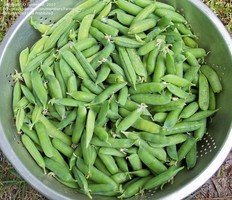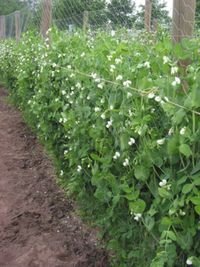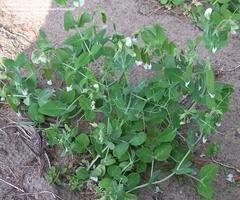





Tall vines or dwarf - which type of pea is right for your garden?
When I first grew peas, I put up fencing for them to climb, and climb they did—to the top of the fence and then down again. When a storm came along with a strong wind, it blew down the fence, all top-heavy with pea vines. So because I am too lazy to put up a stronger fence and too cheap to pay for the sort of sturdy construction they sell in gardening catalogs, I was very happy the next spring to discover that there were dwarf vining varieties of peas that didn't require a trellis.
In fact, dwarf peas have been around for over a century. It was just that I didn't know about them. Today, they are more popular than ever. Looking through this year's gardening catalogs, it is hard to find many of the tall-vining varieties.
The pea (Pisum sativum) is an Old World leguminous vining crop that has been cultivated for thousands of years. Unlike the common beans of the genus Phaseolus, that climb by twining around a support, pea vines produce small coiling tendrils. Until the late 17th century, peas were grown almost entirely as a dried crop that we now call split peas. Then someone discovered how delicious they are when the berries are young and green and sweet. The problem is in picking them when they are young and green and sweet.
There are two basic kinds of pea: smooth-seeded and wrinkled-seeded. The smooth-seeded types are starchier and generally grown as a dried crop; these are often referred to as field peas. The wrinkled-seeded peas are the sweet ones that are best when very young. As wrinkled-seeded pea berries mature in the pod, they loose their sweetness, turning starchy and even bitter.
 Among the sweet peas, there are three different kinds: Shelling peas, otherwise known as green peas or English peas, do not have edible pods. Edible-podded peas, which are rapidly growing in popularity, include the flat-podded snow pea and the newer thick-podded snap pea.
Among the sweet peas, there are three different kinds: Shelling peas, otherwise known as green peas or English peas, do not have edible pods. Edible-podded peas, which are rapidly growing in popularity, include the flat-podded snow pea and the newer thick-podded snap pea.
All these different varieties of peas can be found either as long-vined —4 to 6 feet tall— or dwarf-vined types that only grow 2 to 3 feet and, at least in theory, do not require support.
As with beans, the difference between the tall and shorter versions lies in determinacy. An indeterminate plant will keep growing and setting new fruits for the entire growing season. To breed a dwarf variety of the same plant, it is made determinate, pre-programmed to stop growing and producing at a certain point. In the case of peas, the flowers emerge from nodes along the vine. In a determinate variety, after the flowers from a given node have bloomed, the plant does not grow past that point. Today's new dwarf varieties of peas are at least semi-determinate, and this is why they are dwarfed. It must be noted, however, that even a determinate plant will produce a second crop if the first one is harvested early, before it matures.
Determinacy is desired by commercial growers for the canning and freezing markets because they use mechanical harvesting methods that strip the pods in the field to avoid the labor and expense of trellising and hand picking. Since this is a one-time-only operation, it is crucial that it be done when the largest percentage of the peas in a given field are at optimum growth, not too old or too young.
But for the home gardener and the market gardener aiming at the fresh market, where the crop is usually picked by hand, the quality of the crop is often more important. The peak of flavor and tenderness in peas may be lost in as little as a day; the berries rapidly lose their sweetness, and edible pods turn tough and fiberous if picking is delayed. For many gardeners, extending the season is more desireable than ensuring a large crop all at once for processing.
Unlike beans, which also come in short and tall varieties, the pea is a cool-season crop. When the weather turns hot in the summer, most varieties of peas will cease bearing . Many gardeners have been frustrated in growing peas when, just as the vines begin to set fruit, a hot spell comes along and puts a premature end to the season. For this reason, except in cooler climates, there is little benefit to a long-season indeterminate vine, particularly if it takes longer to begin producing.
. Many gardeners have been frustrated in growing peas when, just as the vines begin to set fruit, a hot spell comes along and puts a premature end to the season. For this reason, except in cooler climates, there is little benefit to a long-season indeterminate vine, particularly if it takes longer to begin producing.
Advantages of Tall Vines:
Ease in picking. With tall vines grown on a trellis the pain of bending over to pick the peas is greatly reduced.
Yield. Tall vines on a trellis or other upright support will yield more per square foot than shorter varieties, particularly in an extended season.
Longer productive season—if your climate allows.
Advantages of Dwarf Vines:
No need for a trellis. [Actually, I find that even the shorter vines benefit by having some support, and it is easier to spot the often-elusive pods for picking when the vines are upright. But this support need not be a tall fence or trellis. Being lazy and cheap, I find that a few stakes and a roll of twine will hold up my pea vines just fine.]
Quality. Where many bean growers will swear by the good old-fashioned taste of the pole varieties, in the case of peas, the advantage is in the newer, dwarf varieties. Plant breeders are producing sweeter peas, peas that hold their sweetness longer after picking, more tender edible pods, but this research is concentrated on the shorter-vining types.
Maturity. New extra-early varieties of peas may bear in less than 50 days, ideal for short springs in regions where summer heat keeps peas from thriving.
Growing Tips:
Peas should be direct-sown in the ground early in the spring. Spacing should be tight—one or two inches apart in the row; peas don't need to be thinned after sprouting.
Feed with a balanced fertilizer. Peas need phosphorus to produce a good crop but not excessive nitrogen; they produce their own.
When planting, leave enough room between rows to access the vines for picking. If growing tall-vining peas, a supporting fence can be placed between a double row of vines six inches apart.
Pick fresh peas frequently for best quality. Shelling peas are at their sweetest and best before the peas have completely filled the pod. Flat-podded snow peas should be picked as soon as the pods reach edible size before the peas develop inside. Snap peas should also be picked while they are still tender, as soon as the pods swell. Edible-podded peas will keep longer in the refrigerator than shelling peas, which should be shelled and cooked (or eaten) as soon as possible. Some new varieties are supposed to hold their sweetness longer.
To extend the harvest, be sure not to leave any peas on the vine to mature. Even determinate varieties may bear another crop if they think they have lost the first one.
Another way of extending the harvest, particularly when growing dwarf vines, is to make successive plantings every few weeks. Alternatively, you can plant both early and later-maturing varieties.
The season for fresh peas may be short, but it is definitely worth it.
Photo Credits:
Thanks to Farmerdill for the use of his photos from PlantFiles.
Tall mange-tout peas: Permission is granted to copy, distribute and/or modify this document under the terms of the GNU Free Documentation License, Version 1.2 or any later version published by the Free Software Foundation; with no Invariant Sections, no Front-Cover Texts, and no Back-Cover Texts. A copy of the license is included in the section entitled "GNU Free Documentation License".
Copyright © www.100flowers.win Botanic Garden All Rights Reserved